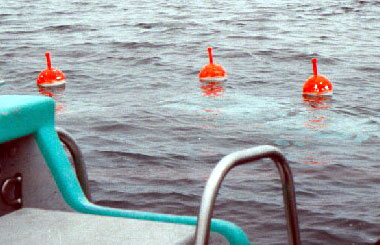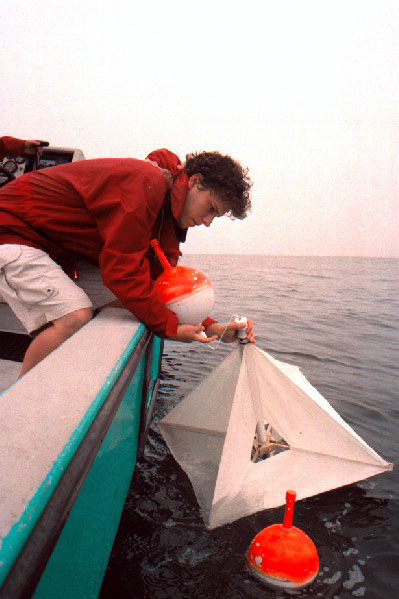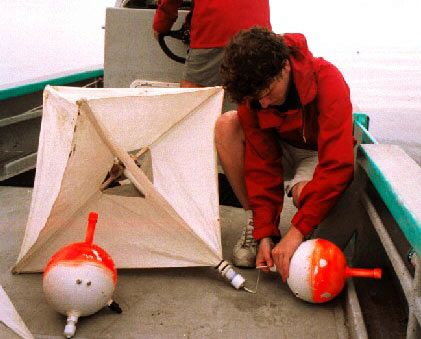|
TRANSPORT OVER
THE INNER SHELF OF
THE SANTA BARBARA CHANNEL
Principal Investigator:
J. Carter Ohlmann (UCSB)
Project
Objectives
 The primary goals of this
research were to collect surface current data over the inner-shelf of
the Santa Barbara Channel with Pacific Gyre’s “Microstar” Lagrangian
drifters, and use the data to: identify characteristic features
of the flow field such as convergences, divergences and cross shelf
transports, determine the surface velocity and velocity variance
distributions, examine flow patterns on scales that are too small to be
resolved in CODAR current measurements, and investigate how well
particle paths determined from Eulerian CODAR fields represent measured
Lagrangian flows. The primary goals of this
research were to collect surface current data over the inner-shelf of
the Santa Barbara Channel with Pacific Gyre’s “Microstar” Lagrangian
drifters, and use the data to: identify characteristic features
of the flow field such as convergences, divergences and cross shelf
transports, determine the surface velocity and velocity variance
distributions, examine flow patterns on scales that are too small to be
resolved in CODAR current measurements, and investigate how well
particle paths determined from Eulerian CODAR fields represent measured
Lagrangian flows.
Summary of Research
 The final set
of drifter deployments directly related to the project was carried out
on 12, December 2003. This gives a total of nearly 200
high-resolution drifter tracks collected during the project. The
data processing codes were rewritten to properly handle parsing of
multiple deployments of a single drifter in a day, to eliminate data
when drifters are clearly caught in kelp beds, and to eliminate data
records recorded during times when drifters were aboard boat. The
final processed data are now available via the Web: (http://www.icess.ucsb.edu/~kirk/drifter/analysis.htm). The final set
of drifter deployments directly related to the project was carried out
on 12, December 2003. This gives a total of nearly 200
high-resolution drifter tracks collected during the project. The
data processing codes were rewritten to properly handle parsing of
multiple deployments of a single drifter in a day, to eliminate data
when drifters are clearly caught in kelp beds, and to eliminate data
records recorded during times when drifters were aboard boat. The
final processed data are now available via the Web: (http://www.icess.ucsb.edu/~kirk/drifter/analysis.htm).
The short drifter tracks collected do
not resolve a complete tidal cycle. Therefore, as a first
analysis step, high frequency (h.f.) radar data and a tidal model were
incorporated to resolve tidal signals. A considerable effort went
into modeling tides to demonstrate that the drifters are not just
measuring tidal currents.
 Drifter data
have been used for an improved validation of h.f. radar derived
velocities. As the number of drifters sampling within an h.f.
radar grid cell increases, so does the rms error in currents from the
two sampling platforms. This suggests that up to 50% of the error
previously reported in h.f. radar data is due to a discrepancy in
sampling scales, and not due to error in h.f. radar or its sampling
technique. A comparison between actual drifter trajectories and
trajectories derived from h.f. radar fields shows a bias in position of
more than 1 km after 3 hours, with the greatest discrepancy in the
along-shore component. Such differences must be reconciled if
h.f. radar fields are to be used to understand and forecast how passive
tracers such as pollutants and objects lost-at-sea move through the
coastal ocean.
|
[homepage]
|
[overview]
|
[researchers]
| [trainees
& staff]
|
[research] | [download reports]
|
|

